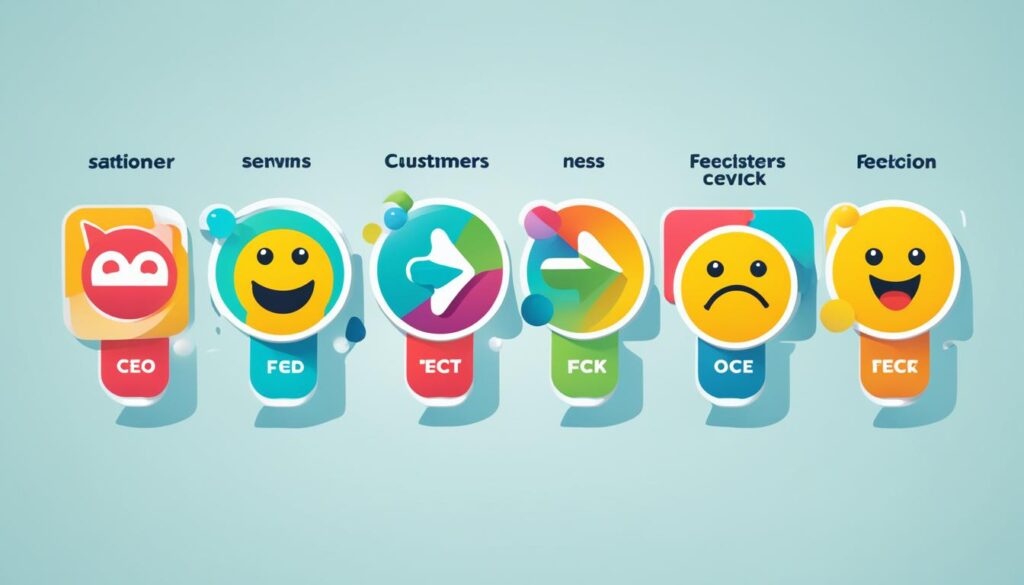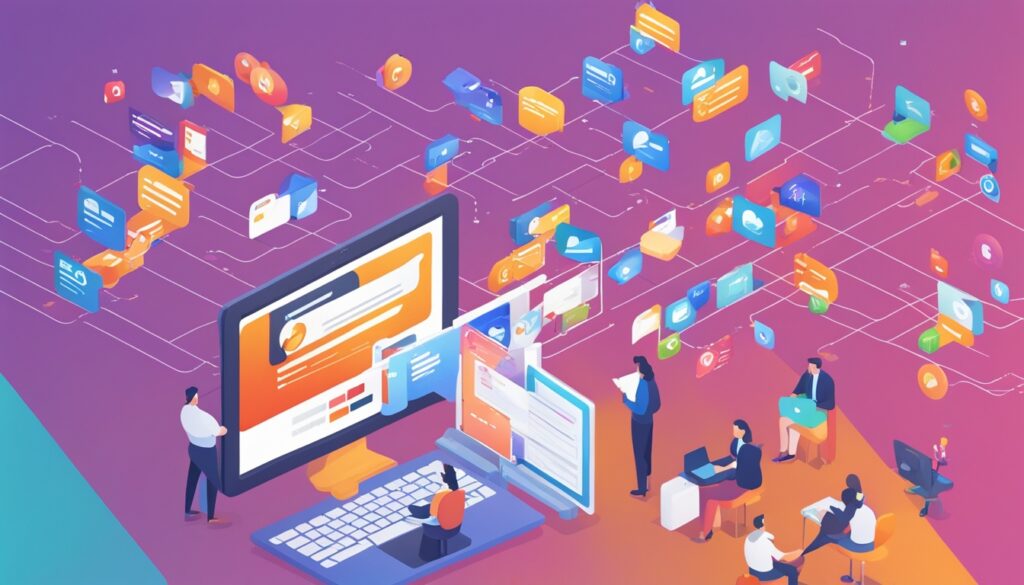Ever wondered why some businesses do well while others don’t? It might be how they use customer feedback. In today’s market, knowing and using customer insights is key to success.
Nowadays, customer feedback is crucial. It’s not just about hearing what people say. It’s about using those insights to make things better and grow the business. Did you know 59 percent of customers would tell a friend about a brand based on the service they got1? This shows how important good customer experiences are and why getting feedback matters.
Companies that really listen to customer feedback get a clear view of the market and what customers want. This leads to better products and happier customers2. By using different ways to collect feedback, companies can find out what they need to do better.
Customer feedback comes in many forms, like surveys or just what people say. Important numbers like Customer Satisfaction (CSAT), Net Promoter Score (NPS), and Customer Retention Rate show how loyal and happy customers are3. When you add in what people say, you get a full picture of what customers think and like.
This article will look into customer feedback, including different ways to collect it and how to use review invitations well. By the end, you’ll know how to use customer insights to move your business forward.
Key Takeaways
- Customer feedback is key for business success and growth
- Processing feedback well leads to better products
- There are many ways to get customer feedback
- Review invitations are a good way to get insights
- Both numbers and what people say are important in feedback
- Using feedback can change how a business works
- Feedback can make the customer experience better
Understanding Customer Feedback and Its Importance
Customer feedback is crucial for business growth. It helps unlock valuable insights and improve products. A whopping 63% of consumers think companies need to listen better to feedback4. This shows how important customer opinions are in shaping business plans.
Feedback helps build customer loyalty and guides business decisions. By using a strong feedback loop, companies can understand what customers want and need. In fact, 60% of consumers would buy more if treated better4. This proves that happy customers can lead to more sales.
Businesses use many ways to get this important feedback. Online surveys and questionnaires are great for getting lots of feedback. They should be easy to understand, offer different types of questions, and make it easy to skip questions5. Social media is also a good place to see what customers think and talk directly with them5.
The Net Promoter Score® (NPS) measures how loyal customers are. It sorts customers into detractors, passives, and promoters, showing how happy they are6. By looking at NPS, companies can plan better to keep customers and see where they can do better.
The aim is to not just get feedback, but to use it. The ACAF (ask, categorize, act, follow up) feedback loop makes sure customer thoughts are used to improve the business6. This active use of feedback is key for success and growth over time.
Types of Customer Feedback
Customer feedback comes in many forms, each giving us unique insights into what customers like and dislike. We’ve found 12 main types, from product feedback to tracking when customers stop buying7. These can be split into two main groups: passive and active feedback7.
Customer surveys, like the Net Promoter Score and Satisfaction surveys, give us structured feedback. Social media, however, gives us real-time feedback but can be hard to pinpoint issues78.
Review portals and in-app ratings help customers make choices and improve businesses. Quick responses to both good and bad reviews build trust and boost online reputation7.

Website analytics and user experience data give us clues about what customers do and think. When combined with call center data, they paint a full picture of the customer journey8.
Interestingly, 77% of consumers like companies more when they listen and act on feedback. Also, 59% sees brands in a better light if they answer complaints on social media9.
| Feedback Type | Characteristics | Benefits |
|---|---|---|
| Customer Surveys | Structured, quantifiable | Easy to analyze, track trends |
| Social Media Feedback | Real-time, public | Immediate insights, brand reputation impact |
| Website Analytics | Behavioral, passive | Unbiased user behavior insights |
| Review Portals | Detailed, customer-driven | Influences purchase decisions, provides improvement areas |
Using an omnichannel feedback approach, businesses can collect feedback from many platforms. This way, they get a full picture of what customers think and feel9.
The Customer Feedback Loop
The customer feedback loop is a process that helps improve and make customers happier. It has four main steps: gather, segment, analyze, and act. By using this loop, companies can increase their profits by up to 60% compared to those not focusing on customers10.
It’s important to collect feedback since only 4 out of 100 customers usually share their bad experiences11. This shows why it’s key to ask for feedback. Popular ways to get feedback include surveys like the Net Promoter Score (NPS), Customer Satisfaction Score (CSAT), and Customer Effort Score (CES)10.

After getting feedback, the next step is to analyze it. This means sorting the feedback into areas like improving products, better customer service, enhancing user experience, and adjusting prices. Properly segmenting feedback helps focus on what to do next and use resources wisely10.
The last step is taking action on what we learn. This can mean many things:
- Making changes based on what customers say
- Telling customers about the changes
- Using their ideas in product development
- Asking customers to test new features
By closing the feedback loop, companies can see big improvements. These include more people buying, keeping customers longer, reducing losses, and increasing how much customers spend over time10. Customers are also willing to pay 16% more for a better experience, showing the financial gains of this method10.
The feedback loop keeps going. Regular surveys and always checking in with customers make sure their thoughts are always part of the business. This creates a culture of always getting better and focusing on customers12.
Feedback Collection Channels
Businesses use many ways to get customer feedback, each with its own benefits. Email surveys are a top choice, giving deep insights. In-app surveys give quick feedback on certain features, and website feedback widgets make it easy for customers to share thoughts1314.
Customer interviews, either via video or in person, give valuable insights to improve experiences. Social media helps track what people say about a brand and how happy they are. Review platforms, like app stores, are key in making products better based on ratings and feedback14.

Digital ways like email, social media, and online surveys give businesses many options to hear from customers. Old-school methods like talking face-to-face and on the phone are still important. The right feedback channels can greatly help in making business decisions and building better customer relationships13.
| Channel | Strengths | Best Use Case |
|---|---|---|
| Email Surveys | Detailed insights | In-depth feedback on overall experience |
| In-App Surveys | Quick, contextual feedback | Feature-specific insights |
| Website Widgets | Easy communication | Real-time website experience feedback |
| Customer Interviews | Rich, qualitative insights | Understanding complex user needs |
| Social Media Monitoring | Brand perception insights | Tracking sentiment and trends |
Choosing the right feedback channels can be tough. It’s important to make them easy to use and to understand the data well. To get the most out of it, businesses should let customers give feedback anonymously and offer it in many languages13.
Customer feedback groups let people share ideas and report bugs, cutting down on time and cost. Chatbots are a fun way to get feedback, using AI to make it better15.
Conclusion
We’ve looked at how important customer feedback is for a good feedback strategy. By using different ways to get feedback, companies can learn a lot to make things better for customers. Remember, only about 4% of unhappy customers tell a business about their issues16.
Having a strong system for managing feedback helps put the customer first. Tools like Customerly offer many types of surveys and an easy-to-use dashboard. This lets businesses see what customers think right away and make them happier17. Using both kinds of feedback helps companies understand what customers want and like18.
Using feedback to make smart decisions is key for growing a business. Since 90% of customers check reviews online before buying, it’s crucial to listen to what customers say16. By focusing on important feedback and matching it with product plans, companies can fix customer issues and make their products better18. A good feedback strategy not only makes customers happier but also keeps them coming back and helps the business do well.
FAQ
What is customer feedback?
Why is customer feedback important?
What are the different types of customer feedback?
What is the customer feedback loop?
What are some channels for collecting customer feedback?
How can businesses implement an effective customer feedback strategy?
Source Links
- Customer Feedback: How to Collect It, Respond to It, and Act on It – https://www.jotform.com/customer-feedback/
- How to Organize Customer Feedback | Productboard – https://www.productboard.com/blog/how-to-organize-customer-feedback/
- Customer Feedback Analysis: How To Guide & Tips – https://www.kapiche.com/blog/customer-feedback-analysis
- What Customer Feedback To Collect – And When – https://www.qualtrics.com/experience-management/customer/collecting-customer-feedback/
- What Is Customer Feedback Across Different Channels – https://www.savio.io/blog/what-is-customer-feedback-across-different-channels-and-when-to-collect-it/
- Customer feedback: 7 strategies to collect and leverage it – https://www.zendesk.com/blog/customer-feedback-hear-voice-customer/
- Different Types of Customer Feedback (And How to Address Them) – https://rapidr.io/blog/customer-feedback-types/
- Multichannel Customer Feedback | Qualtrics – https://www.qualtrics.com/en-gb/experience-management/customer/connecting-customer-feedback/
- How To Collect Customer Feedback – 6 Methods – https://monkeylearn.com/blog/customer-feedback-methods/
- What is a Customer Feedback Loop and Why Do You Need One? – https://survicate.com/customer-feedback/loop/
- Here’s How To Design A Customer Feedback Loop That Works – https://surveysparrow.com/blog/customer-feedback-loop/
- Customer Feedback Loop: Establishing and maintaining effective channels for gathering and implementing customer feedback – https://www.linkedin.com/pulse/customer-feedback-loop-establishing-maintaining-sakshi-gupta-cspo–mel8e
- What is a Feedback Channel? – https://www.anecdoteai.com/blog/feedback-channel-customer-feedback-analytics-explained
- Customer Feedback Management (Types, Channels, Tools) – https://survicate.com/customer-feedback/feedback-management/
- 10+ Customer Feedback Channels & Feedback Tools You Can Use | UseResponse – https://useresponse.com/blog/how-to-gather-quality-feedback/
- 4 Channels to collect customer feedback you’re probably missing – Trustpilot Business Blog – https://ie.business.trustpilot.com/reviews/learn-from-customers/4-channels-to-collect-customer-feedback-youre-probably-missing
- The Customer Feedback Loop: From Insights to Action | Customerly – https://www.customerly.io/blog/customer-feedback-loop/
- A Complete Guide to Customer Feedback | UserVoice Blog – https://www.uservoice.com/blog/customer-feedback

